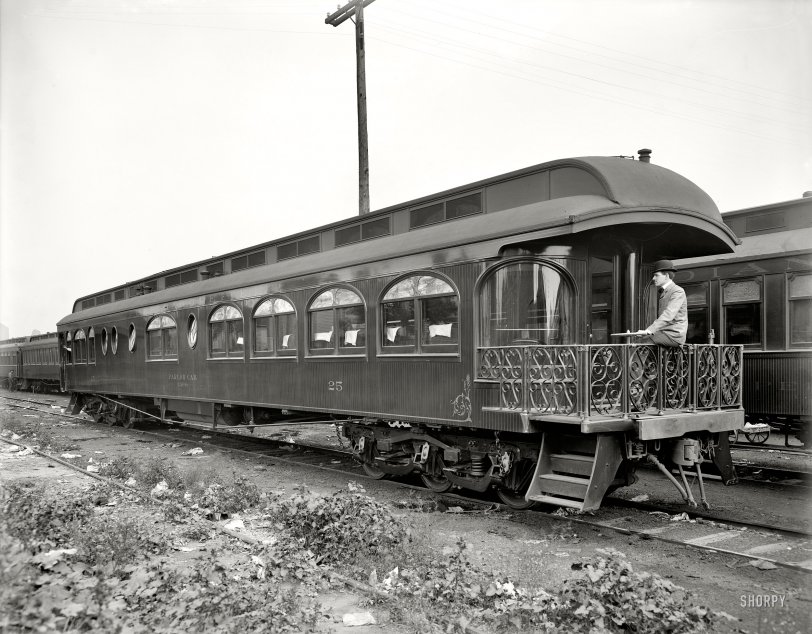


Framed or unframed, desk size to sofa size, printed by us in Arizona and Alabama since 2007. Explore now.
Shorpy is funded by you. Patreon contributors get an ad-free experience.
Learn more.

- Baldwin 62303
- Baldwin VO-1000
- Cold
- No expense spared
- Tough Guys
- Lost in Toyland
- And without gloves
- If I were a blindfolded time traveler
- Smoke Consumer Also Cooks
- Oh that stove!
- Possibly still there?
- What?!?
- $100 Reward
- Freeze Frame
- Texas Flyer wanted
- Just a Year Too Soon
- WWII -- Replacing men with women at the railroad crossing.
- Yes, Icing
- You kids drive me nuts!
- NOT An Easy Job
- I wonder
- Just add window boxes
- Icing Platform?
- Indiana Harbor Belt abides
- Freezing haze
- Corrections (for those who care)
- C&NW at Nelson
- Fallen Flags
- A dangerous job made worse
- Water Stop
Print Emporium
Car 25: 1905

Circa 1905. "Pere Marquette Railroad parlor car No. 25, exterior." 8x10 inch dry plate glass negative, Detroit Publishing Company. View full size.
Re: Handshakes
Thanks to all who jumped right in with explanations for my previous comment. Shorpy readers are the best! No question remains unresolved very long here. I learn something new every day.
Thanks Dave, for this entertaining and educational site.
Three Lines
The three lines most likely are: air brakes, steam heat and train signal line. The signal line permitted the conductor (by a small valve located on the bulkhead) to give whistle signals to the locomotive crew.
Air Signal line
One of those extra air hoses on the end of the car is probably for the train air signal line. The other line I am not sure about without looking at some old books I have. The cars probably had stoves for heat and it's not the right size or type of connection for steam heat. It seems like I should know, but I just cannot recall what the third line would be for.
Multiple Hoses
One hose was the air brakes. A second was steam heat. The third may have either been for steam (connections look similar) or for drinking water. Only the air brakes would have been needed on a freight car.
The Hoses
The three hoses you see are, from smallest to biggest, the train signal line, the air brake trainline and the steam heat line. The air line for the signal connected to a whistle in the locomotive cab so that the conductor could, through a series of long or short tugs on the valve, signal to stop at the next station, supply more steam for heat, etc.
The air brake line carried 90 to 110 psi compressed air and by reducing the pressure in this line would apply the brakes throughout the entire train.
The third and largest hose supplied steam used for heating the cars, a big improvement over the coal stoves used previously which tended to ignite these varnished wooden cars rather quickly in a wreck!
Handshakes
I can't remember ever seeing a three line air system on any rail cars I am familiar with. Nowadays only one is used.
I have no doubt someone will come along shortly with a perfectly reasonable and technical explanation for us all.
It's all in the detail
So nice to see the livery and striping details on these Cars. The flourished ends are a nice touch, tradesman at work. In our modern age it is really a treat to see great resource for signpainting restored cars such as these.
GR&I
Look like Grand Rapids & Indiana cars in the background. Another railroad providing service to Michigan's "Sportsman's Paradise." Could be at Muskegon or Grand Rapids. I think the GR&I and PM crossed paths at these cities, maybe others.
Cheers
Is someone proposing a toast from yon window?
Garbage
What is a bit surprising to me is the amount of litter all over the ground. I'd think a railroad wanting to show off its equipment would want the best representation possible. Or maybe somebody just took a snapshot of a lone car on a siding.
[8x10 glass negatives aren't what most people would consider casual photography. Made with big heavy view cameras on tripods. - Dave]
Details of Car
The following details come from the book, Mr. Pullman's Elegant Palace Car by Lucius Beebe, 1961:
Superb examples of American Car & Foundry craftsmanship are these two palace cars frin the collection of Arthur D. Durbin [pictures differ from what Shorpy shows]. The Pere Marquette's parlor-cafe No. 25 was in built at A.C.F.'s Jeffersonville shops in 1903 and assigned to the Northern Michigan vacation service on trains No. 1 and 5, and Nos. 9 and 10, the Resort Special. Of this train the public timetable for 1905 of the Great Central route of which the Pere Marquette was a component, says, 'Trains No. 1 and 5 will stop at Little Manistee River (Fishing Camp) on signal,' an index of casual operation in good old summer days. The car was characterized by a curved rear bulkhead with plate-glass windows to match, giving onto an observation platform of uncommon depth.
The Little Manistee River is on the western shores of the lower peninsula of Michigan between Ludington and Frankfort.
























On Shorpy:
Today’s Top 5